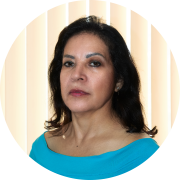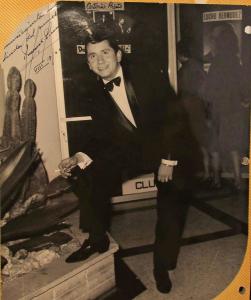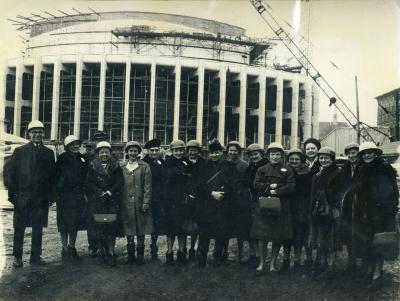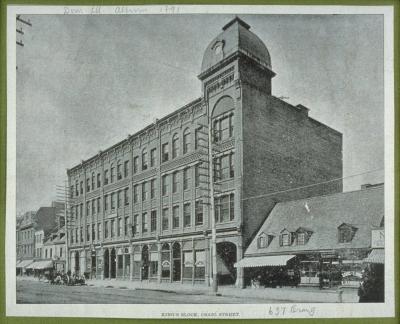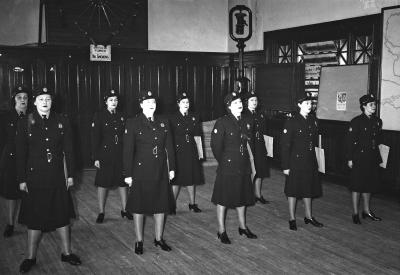Since the 1960s, Montréal has been home to a flourishing Latin American music scene. A wide variety of origins and influences have come together, resulting in music that has helped build bridges between Montrealers from all over.
The story of Latin American music and its fans in Montréal shines a spotlight on many remarkable artists, venues, and performances. It also showcases music’s role connecting Latin Americans and Quebecers of all origins, and the ways Latin Americans have enriched Québec culture through fusions of Latin American rhythms from near and far.
1960–1980: The beginnings
Montréal’s connection with Latin American music dates back to the 1960s. The first Latin American musicians to make a name for themselves were two brothers from Matanzas, Cuba, named Merci and Cuco Gonzalez. The Gonzalez brothers played bolero, a style of ballad that originated in Cuba, accompanied by Haitian musicians. Expo 67 brought José Armando Torres, better known by his stage name Joé Armando, to Montréal. At the time, Torres was bandleader of Orquesta Colombia Cumbia, an ensemble that brought together a musically diverse collection of talented Colombian musicians. The group’s success at Expo 67 led to a contract at Montréal’s Tropicana club and performances around the province. Torres recalls that Montréal in those days was one of North America’s most vibrant cultural hubs, which is why he chose to make it his home. José Armando Torres remains a guiding presence for new Latin American bands in Montréal to this day.
In the late 1970s and through the 1980s, tango eclipsed all other Latin American music in Montréal in terms of popularity. Cultural observer Claudine Audet noted that, since that period, Montréal and New York have vied for the unofficial title of North American tango capital. For Gerardo Sanchez, dancer and artistic director at Tango Libre dance company, Montréal is considered “the fourth-largest world Tango centre” after Buenos Aires, Amsterdam, and Berlin.
The 1980s: New elements, new styles
In the early 1980s, Cuban musicians like Lazaro Rene and his brother began making waves playing traditional Cuban music in Montréal. The province’s large community of world music fans embraced Cuban music and learned Cuban dances. Many went further, visiting Cuba to experience the music and culture firsthand. This groundswell of interest coupled with the presence of local salsa bands in Montréal inspired Québec music producers and promoters to host performances and create a salsa scene. Montrealers of all stripes were brought together by their love of Latin American music.
The 1980s saw many groups form with members from Québec alongside Latin American musicians. For the first time, Montréal spawned a fusion of local sounds and Latin American stylings. Since the early 1970s, Latin American music in Montréal had been promoted and broadcast largely by a community radio station called Radio Centre-Ville, as well as at clubs and private parties. While the wave of Chilean refugees meant that Chilean contemporary music figured prominently, Radio Centre-Ville also played salsa and other popular genres, especially dance music.
The 1990s: Diversifying musical styles
Jorge Ross et son orchestre Pambiche
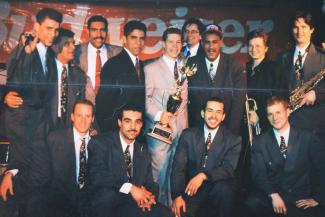
In the 1990s, Montréal saw an explosion of Latin American music in many different styles. This effervescence was led by DJs of Spanish-American and Brazilian origin who had settled in Montréal in the late 1980s. During this period, around ten Latin American live bands regularly played around the city. Most had their roots in the Spanish-speaking Caribbean, and they played traditional Cuban, Dominican, Puerto Rican, and Colombian-Venezuelan music. Among the best known of these groups were Orquesta La Moda, Joé Armando and his group, Timbros and his band, Tombroc, Orquesta Tambora, Latins Show, and Orquesta Canela.
But by the late 1990s and early 2000s, the big bands began to disappear. Groups of more than six musicians had become unsustainable, as electronic instruments began to replace their acoustic counterparts. Caribbean instrumental bands were hit especially hard. With the difficulties of earning a living, most of these groups began to vanish. In those years, the most popular Latin American music genres in Montréal were the salsa, merengue, cumbia, and bachata.
Dance clubs were the top spots to enjoy Latin American music at the time. Other venues included the Montréal jazz festival, private parties, and the independence-day celebrations of various countries. From 1994 to 1996, the television program Télé-Ritmo V was another important source. Newspapers also ran columns on Latin American music in Montréal. Among the best-known musicians back then, the Dominican saxophonist Jorge “Papo” Ross wrote and performed merengue, salsa and Latin jazz, while the Cuban singer-songwriter Carlos Placeres was known for putting a new spin on the trova cubana tradition. Promoters Edgardo Linares and Andrés Mendoza of Antara Productions were also prominent figures in the Latin American music scene at the time.
The 2000s to the present: Major transformations
Alexander Betancourt [Ramon Chicharron]
![Alexander Betancourt [Ramon Chicharron] sur scène avec sa guitare](https://ville.montreal.qc.ca/memoiresdesmontrealais/sites/default/files/styles/chm-blog-album-article-switcher/public/alexander_betancourt.jpg?itok=rcMKd5r5)
Some music artists have talked about a renaissance in Montréal’s Latin American music scene since 2003, fomented by new musicians who arrived largely from Brazil, Colombia, Cuba, Mexico, and Venezuela. Among the leading lights of this new generation are Pablo Ramos, Monica Freire, Hugat, Julian Gutierrez, Joaquín Dias, and Romulo Larrea.
Montréal has embraced new performers including Boogat, Mamselle Ruiz, Bïa Krieger, Tomás Jensen, Guipi Orchestra, Roberto López, Ramón Chicharron, Los Viejha, Bumaranga, and Jesús Cantero. This new generation’s work is marked by the fusion of rhythms and genres. Artists draw on their roots and come together to create rich hybrid styles.
Bumaranga
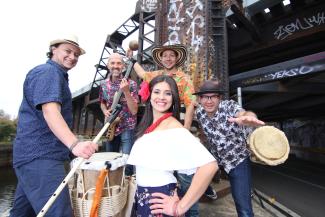
Awards and recognition
École de danse San Tropez
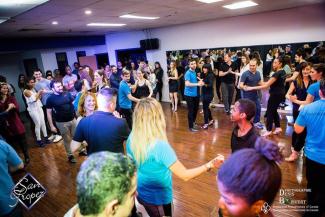
Many Latin American musical acts have won the Syli d’Or for world music excellence, awarded by the Festival International Nuits d’Afrique. These include Cuban band Proyecto Iré in 2016, Chilean singer-songwriter Akawui in 2015, the Afro-Colombian stylings of Bumaranga in 2013, and the Cuban Martinez Show, with its fusion of traditional Cuban music and jazz, in 2011. Other Latin American groups including Los Viejha (2015), and Raíces Caña y Son (2013) have taken home the Syli d’argent award.
Today, Latin American music continues to win over new fans in Québec, where people appreciate the vibrancy, warmth, and festive atmosphere of its rhythms. Since the 2000s, summer festivals have become the place of choice for Latin American musicians to reach large and diverse audiences. Many dance schools have also opened their doors, beginning in the 1990s. The San Tropez dance school was a pioneer on this front. Latin American music and dance in Montréal have been showcased through competitions like the Montréal Salsa Convention, an annual festival focused on salsa performances and workshops that has run since 2004. Montréal has also hosted several percussion festivals. Overall, these efforts have helped make music an important bridge, connecting Latin Americans in Montréal with people from other cultures.
Interviews for this article were held with members of Montréal’s arts community: Joé Armando (musician of Colombian origin), Carlos Placeres (musician of Cuban origin), Jorge “Papo” Ross (musician of Dominican origin), Mamselle Ruiz (singer of Mexican origin), Bïa Krieger (singer of Brazilian origin). Two non-musicians from the Montréal arts community were also interviewed: Marie-Claude Roy (arts promoter) and Yves Bernard (journalist specialized in fusion-genre music).
